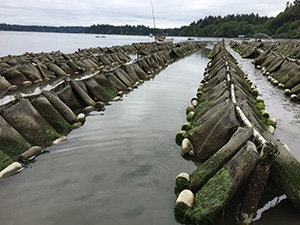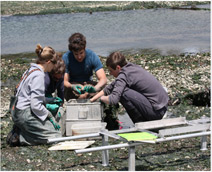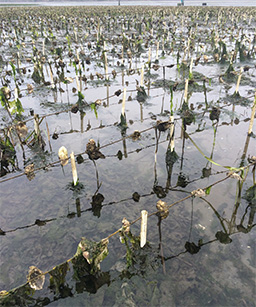|
Oyster culture practices are changing rapidly on the U.S. West Coast from conventional on bottom to off-bottom methods. Primary reasons for this shift include a renewed interest in expanding the industry, and growing consumer demand for a visually pleasing deep cupped and uniform single in-shell oyster. This premium product is best produced using off-bottom cultivation practices, especially flip-bags. Longlines are another off-bottom culture method used in recent years, often installed at densities up to several acres in size. It’s unclear how these large arrays may affect direction and velocity of tidal currents, sediment transport and deposition, light and phytoplankton availability. Off-bottom oysters filter up to four times as much as on-bottom oysters (Wheat and Ruesink, 2013), which may impact neighboring shellfish farms.

An array of "flip-bags", an off-bottom method of cultivating oysters to be sold as singles. Photo: Eld Inlet
This research will evaluate the effects of off-bottom oyster culture on the local environment and neighboring shellfish operations. Collected data will inform predictive models to evaluate farm effects at different spatial scales and under a variety of scenarios. Findings from this study will be used to site structures to maximum sustainable production and to help develop best management practices (BMPs) in collaboration with regional shellfish farmers.
Off-bottom oyster culture will be assessed at 3 primary growing areas: Willapa Bay (southern coastal Washington), Eld Inlet (South Puget Sound), and Samish Bay (North Puget Sound). In addition to directly comparing on-site and off-site data, we will utilize existing models to predict additional effects under different production scenarios; increased size of arrays, stocking density, and shellfish age or size. A workshop will be held to present results and develop best management practices (BMPs) with stakeholders.
The core research team includes: Steve Booth (PI) and Bobbi Hudson (Pacific Shellfish Institute), John Richardson (Bluehill Hydraulics), John Rybczyk (Huxley College) and Kim Patten (WSUREU). This work is supported by the NOAA Saltonstall-Kennedy program grant no. 2004980.
Project Partners:
Bluehill Hydraulics
Huxley College
WSUREU
Project Summary (printable 1-pg PDF) |
|
|
Off-Bottom Methods:
A new set of Pacific oyster "seed" on shell or cultch, strung on poly lines. PVC pipes hold lines in place as oysters grow in clusters to harvest size.
Flip-bag oysters destined for the singles market, buoys allow bags to rise and fall with the tide.
|
|
|














